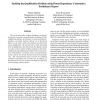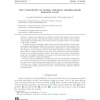529 search results - page 60 / 106 » Causal Time Calculus |
TIME
1998
IEEE
14 years 1 months ago
1998
IEEE
The use of causal rules or fluent dependency constraints has proven to provide a versatile means of dealing with the ramification problem. In this paper we show how fluent depende...
CORR
2008
Springer
13 years 8 months ago
2008
Springer
Here is proposed a review of the different choices to structure spike trains, using deterministic metrics. Temporal constraints observed in biological or computational spike train...
ENTCS
2010
13 years 6 months ago
2010
We study the biochemical processes involved in scaffold-mediated crosstalk between the cAMP and the Raf-1/MEK/ERK pathways. We model the system by a continuous time Markov chain w...
GECCO
2009
Springer
14 years 1 months ago
2009
Springer
The synthesis of stochastic processes using genetic programming is investigated. Stochastic process behaviours take the form of time series data, in which quantities of interest v...
LMCS
2007
13 years 8 months ago
2007
Higher-Order Fixpoint Logic (HFL) is a hybrid of the simply typed λ-calculus and the modal µ-calculus. This makes it a highly expressive temporal logic that is capable of express...


